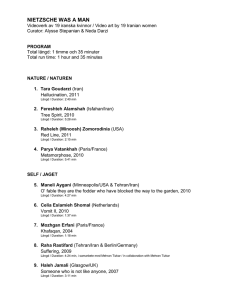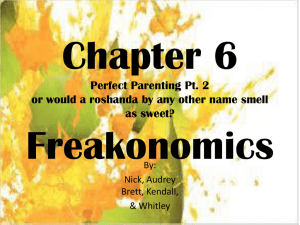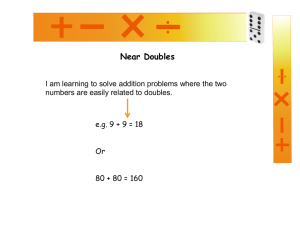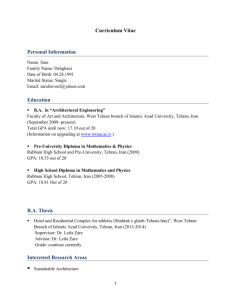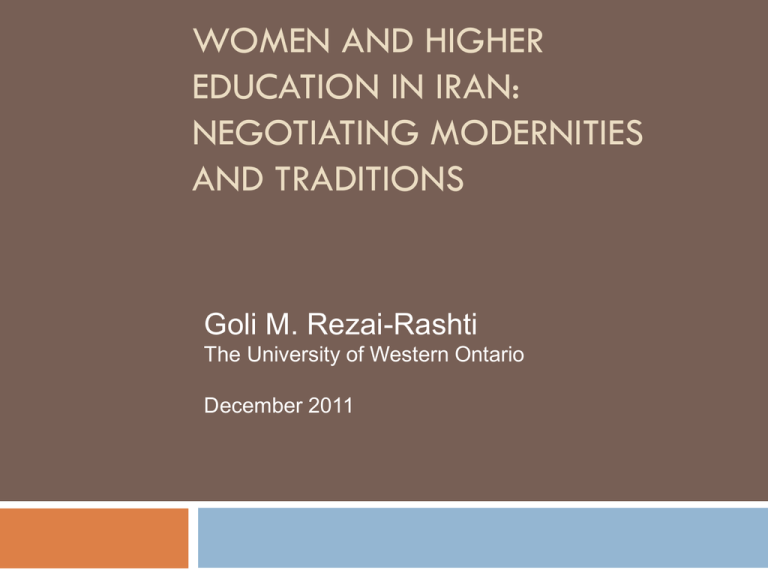
WOMEN AND HIGHER
EDUCATION IN IRAN:
NEGOTIATING MODERNITIES
AND TRADITIONS
Goli M. Rezai-Rashti
The University of Western Ontario
December 2011
Objectives
2
Examine patterns and trends in women’s access to
higher education across 3 periods:
1.
2.
3.
The highly ideological 1980s
Liberalization and reform, 1990-2005
Ahmedinejad era of neofundamentalism 2005present
Research Questions
3
How have the advances in women’s higher
education attainment affected their access to paid
employment?
How has higher education attainment affected the
“marriage market”, and gender relations?
1980-1989:
Women & the Ideological State
4
Pahlavi-era Family Protection Act (1967/1973) abrogated.
Ban on women judges
Islamic Cultural Revolution: closures; purges; revised curricula
Islamization of education: sex segregation, compulsory veiling for women;
women barred from some fields of study
Decline of female labor force participation and share of labor force
“Many jobs were declared unsuitable for women, and some laws that
previously protected women’s rights were annulled. Also, family planning
programs as well as most nurseries and kindergartens were shut down, and
the appropriateness of women’s place within the family was advocated.”
(Alaedini and Razavi, 2005: 59)
1990-2005: Liberalization and Reform
5
Removal of quotas for women in higher education
Rafsanjani “called on the female population to strive to take their
50 percent share in the country’s educational programmes and
institutions” (Tehran Times, Sept. 24, 1991, p. 1).
Emergence of independent feminists, women-led NGOs, and
dynamic feminist press
Reform movement exemplified by presidency of Mohammad
Khatami (1997-2005)
Women begin to catch up with, and then overtake, men in higher
education enrollments; feminization of some disciplines.
Table 1. Number and percent of applicants to
university admission exams, 1983-2001, by sex
6
Source: K. Haghighi & N. Akbari, Pezhohesh Zanan, 3(1) (2004): 81.
Table 2: Number and Percent of Women Admitted to
Universities By Field of Study, 1991-2002
7
Source: S. Kazemipour, Investigation and Discussion of Women’s Increased Participation in
Higher Education, Tehran: Ministry of Science, Research & Technology (2004): 34.
(in Persian)
The Ahmadinejad Era
8
A neofundamentalist approach to women’s issues,
including government concerns over women’s higher
enrollments in university.
Repression of women’s rights activism
Controversial bills on “family protection”: enhancing
men’s privileges in marriage and extramarital relations
Enhancement of the nuclear sector (implications for
gendered employment)
Field Research
9
Field work at five universities (4 universities in Tehran, 1 in
Isfahan)
Qualitative research: 51 interviews with male & female
students and 11 professors (3 males and 8 females)
Examination of government documents and secondary sources
Question: How have advances in women’s higher education
attainment affected their access to paid employment and their
labor force share? The interview data offer insights into the
difficulties that women face seeking appropriate employment:
Networks and family connections
Religious environment
Barriers to management and promotion
Mehrieh as a defense mechanism
Voices of Educated Women
10
“You can only find jobs in related areas of specialization if you have an important connection,
especially in the governmental organizations. Most graduates of humanities and social
sciences, for example, are not working in their fields. They find jobs in banks and other
institutions.”
“[In my university] there are all sorts of people, some are very religious and some are ‘normal
like me’. When I complete my degree and find that I cannot obtain a position in my preferred
university [less religious, our emphasis], I will open my own counselling agency and counsel
people who are like me and those who respect me.”
“They were opposing my promotion just because I am a single woman. It was very interesting
for me because I was thinking I may never want to get married, then what? Later, they brought
up my hejab as an excuse. Promotion in the government organization is difficult for women.
They put too many barriers in front of you that you will think the promotion will create more
problems for you. In such case, you would rather stay in the same position quietly and do your
work. However, I think women who are working are more creative and organized and they
relate to people a lot better than men.”
11
Gender Relations & Educated
Women (Mehrieh)
“My family wanted a very high mehrieh. For example, my brother’s wife had a dowry of 714
gold coins. My brother was asking a higher mehrieh for me and his argument was that his own
wife who is a high school graduate was given 714 gold coins, while his sister (me) with a
doctorate should ask for at least 2000 gold coins. I had to intervene and tell them I don’t want
to have a high mehrieh and we settled for 750 gold coins.”
“...I am a strong believer of mehrieh for women. Mehrieh should not be seen in the traditional
sense. In this country women cannot negotiate their civil and legal rights through legal means. I
was married for five years and found out that I could not live with my husband any longer. We
discussed divorce but he said no. My Mehrieh was 1370 sekeh azadi. I threatened that I would
litigate for my mehrieh. This was the only way that I could secure my divorce. I am absolutely sure
that because of this high mehrieh he agreed to divorce.”
“My family wanted a very high mehrieh. For example, my brother’s wife had a Mehrien of 714
gold coins. My brother was asking a higher mehrieh for me and his argument was that his own
wife who is a high school graduate was given 714 gold coins, while his sister (me) with a
doctorate should ask for at least 2000 gold coins. I had to intervene and tell them I don’t want
to have a high mehrieh and we settled for 750 gold coins.”
Gender Relations & Educated Women (cont’d)
12
“I think there is no difference between women and
men. I experienced this myself. When I came to
university, I was staying away from interacting with
men at first but gradually because I was a very good
student during my Bachelor degree, my confidence
was improved and this affected my relationships.
Now, I don’t see any difference between men and
women and I can become friends with them and feel
comfortable and equal.”
Gender Relations & Educated Women (cont’d)
13
“I think there is no difference between women
and men. I experienced this myself. When I
came to university, I was staying away from
interacting with men at first but gradually
because I was a very good student during my
Bachelor degree, my confidence was improved
and this affected my relationships. Now, I don’t
see any difference between men and women
and I can become friends with them and feel
comfortable and equal.”
Gender Relations & Educated Women (cont’d)
14
“While I was studying towards my Bachelor degree I
had many proposals for marriage. After entering
Master’s degree the number of proposals decreased
and by the time I entered Ph.D program, it became
non-existent.”
Gender Relations & Educated Women (cont’d)
15
“I wanted my husband to be accepted in the Ph.D.
program. He wanted it too. We both liked it
…..One of my conditions for the marriage was for
him to get accepted. I wanted my husband to be at
the same level of education.”
Gender Relations & Educated Women (cont’d)
16
“The more education I had, the more worried I was
getting. First of all, there would be fewer cases of
men who would propose to me. Many men might
even be afraid to approach. I think men have
trouble to be involved with someone who has higher
education than them. It rarely happens.”
Table 3: Employment and Unemployment by
Education and Sex, in Percent (1977-2004)
17
Source: S. Kazemipour, Employment Problems of Educated Women in Iran. Tehran: Research Centre for
Cultural and Social Studies (2005) : 18.
Table 4: Share of Women in Academic Positions
at Three Universities, 1991-2001
18
Source: F. Gaeini, Evaluation of women’s status in higher education in the last decade, 1992-1993 & 20022003. Tehran: Public Relations Publisher for Women’s Cultural and Social Organization (2006): 194
Table 5: Number and Percent of Men and Women Employed Fulltime or Part-time at State Universities
19
Source: Institute of Research and Planning of Higher Education. Tehran: 2008, p. 124.
Table 6: Number and Percent Full-Time Female Faculty Members
by Sector and Rank, 2003-2004
20
Source: Higher education in Iran: A National Report 2003. Ministry of Sciences, Research &
Technology: Institute for Research & Planning in Higher Education, p. 75.
Note: Total female share is 14.7%; highest in category “educators” and “others” (24-27%)
Table 7: Number of Female Graduates by Sector and
Study Levels in 2003-2004
21
Source: Higher Education in Iran: A National Report 2003. Ministry of Science, Research & Technology: Institute for
Research & Planning in Higher Education, p.74.
Note: Female share of total is 46.5%. At master’s and Ph.D. level it is 24-27%; professional doctorate, 41.6%.
Table 8: Women in Higher Education, MENA
22
Country
Gross
enrollment
rate, F (M)
% Female
teachers at
tertiary level
Country
Gross enrollment
rate, F (M)
% Female
teachers,
tertiary
Algeria
28 (20)
35
Qatar
27 (9)
37
Bahrain
47 (19)
41
Saudi Arabia
35 (23)
33
Iran
34 (29)
24
Tunisia
37 (25)
41
Jordan
42 (38)
23
Turkey
31 (41)
39
Kuwait
26 (11)
27
UAE
35 (15)
31
Morocco
11 (12)
19
Yemen
5 (14)
16
Oman
28 (23)
29
Source: WEF, Global Gender Gap Report 2009, Table D3, p. 43
Note 1: WB’s WDI 2006 gives total enrollment rates for Egypt (29), Iraq (15), Libya (56). No data for Syria.
Note 2: The proportion female teachers at tertiary level in Iran (24%) is higher than that given in Table 6 (about15%).
Table 9: Female labor force participation and
unemployment, MENA
23
FLFP rate 2004 (F share of total)*
FLFP rate 2008**
F Unemployment , 2007-08**
Algeria
37 (30.2)
38
18.4
Egypt
21.6 (21.8)
23
19.3
Iran
39.1 (33)
31
15.7
Jordan
28.3 (24.1)
23
24.3
Kuwait
49.3 (24.8)
44
n.a.
Libya
32.3 (26.3)
24
n.a.
Morocco
28.5 (25.4)
27
9.8
Syria
39.3 (30.4)
21
13.2
Tunisia
30.4 (27.1)
26
17.3 (2005)
Turkey
29 (26.4)
25
9.4
UAE
38.2 (13.2)
41
7.1 (2004)
Yemen
30.4 (27.7)
20
n.a.
Sources: *World Bank, World Development Indicators 2006, Table 2.2; ** World Bank, WDI 2009. WB source is ILO, KILM.
Note: Iranian census data 2006 gives a figure of 18.5% female labor force share.
Conclusions (1)
24
Women have made considerable progress in access to higher
education, but their participation in the labor market has
remained stagnant (and there are data inconsistencies).
Unemployment rates of educated women are higher than those
of educated men (e.g., 2004: 19% F/7.4% M).
Unemployment as a function of structural and sociodemographic factors: low economic growth, investments in
capital-intensive sectors, rural-urban migration, “youth bulge”.
Conclusions (2)
25
Continued barriers to women’s under-representation in paid
employment: gender bias; resource allocations to capitalintensive/male-intensive sectors (oil, gas, nuclear power)
The practice of mehrieh has not been dying out with
modernization and the expansion of higher education, but
actually expanding, while the amounts have been increasing.
Our interview data suggest that it is a defense mechanism in
the absence of gender equality and meaningful employment
opportunities for women.
Needed: further research into the education-employmentmarriage market intersections, and more attention to the sociopolitical implications of Iran’s “baby boom” generation.


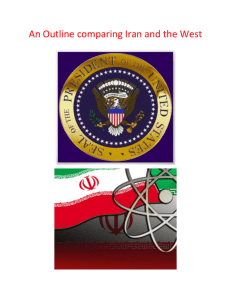
![Amir Shams [ card ] 02](http://s2.studylib.net/store/data/005340099_1-e713f7ae67edd60d4c53ae5bb9448166-300x300.png)
